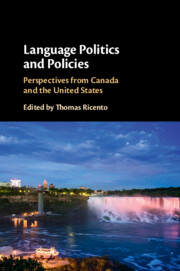Book contents
- Language Politics and Policies
- Language Politics and Policies
- Copyright page
- Dedication
- Contents
- Figures
- Tables
- Contributors
- Preface
- Contributor Personal Statements
- Introduction
- Part I Theoretical Orientations
- Part II The United States Context
- 5 Disciplining Bilingual Education
- 6 Measured Multilingualism
- 7 The Rise, Fall, and Rebirth of Bilingual Education in California and the Ongoing American Dilemma
- 8 Language Policy Conflicts
- 9 Indigenous Language Movements in a Settler State
- 10 The Politics of Language Education Policy Development and Implementation
- Part III The Canadian Context
- Index
- References
9 - Indigenous Language Movements in a Settler State
from Part II - The United States Context
Published online by Cambridge University Press: 18 July 2019
- Language Politics and Policies
- Language Politics and Policies
- Copyright page
- Dedication
- Contents
- Figures
- Tables
- Contributors
- Preface
- Contributor Personal Statements
- Introduction
- Part I Theoretical Orientations
- Part II The United States Context
- 5 Disciplining Bilingual Education
- 6 Measured Multilingualism
- 7 The Rise, Fall, and Rebirth of Bilingual Education in California and the Ongoing American Dilemma
- 8 Language Policy Conflicts
- 9 Indigenous Language Movements in a Settler State
- 10 The Politics of Language Education Policy Development and Implementation
- Part III The Canadian Context
- Index
- References
Summary
Forty years ago there were approximately fifty child speakers of Hawaiian in the state of Hawai‘i. Today there are thousands of speakers of all ages and a constellation of pre-K–PhD programs to promote the Hawaiian language and culture. In the early 1990s, there were no living speakers of myaamia (Miami) or Wôpanâak (Wampanoag), both North American Algonquian languages. Today, these languages, once decreed “extinct,” live in vibrant community-based education programs and family homes. Drawing on an international scholarly literature and the author’s long-term collaborative research with Indigenous educators, this chapter reflects backward and forward on the field of Indigenous language reclamation, tracing its development against the violence of settler colonialism and exploring current movements, their challenges, and the language planning and policymaking possibilities they suggest. In an age of growing raciolinguistic inequality, these movements provide both a cautionary tale and a vision of the interventions necessary to support Indigenous self-determination and sustain linguistic diversity for all.
Keywords
- Type
- Chapter
- Information
- Language Politics and PoliciesPerspectives from Canada and the United States, pp. 173 - 191Publisher: Cambridge University PressPrint publication year: 2019
References
- 2
- Cited by



